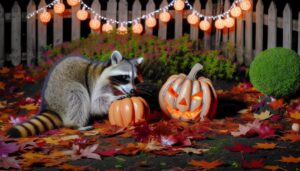Do Raccoons Eat Hummingbird Food?
Raccoons are known for their opportunistic feeding behaviors and may consume hummingbird food, particularly the sugary nectar found in feeders. Their nocturnal nature and keen sense of smell make them likely to visit feeders at night.
Common signs of raccoon activity include tipped-over feeders, spilled nectar, and distinctive claw marks. To protect hummingbird feeders, make sure they are placed at elevated heights and away from structures raccoons can climb.
Additionally, using baffles and motion-activated lights can deter raccoons effectively. By considering these strategies, you can minimize raccoon interference and guarantee a steady supply of food for hummingbirds.
Learn more on this subject.
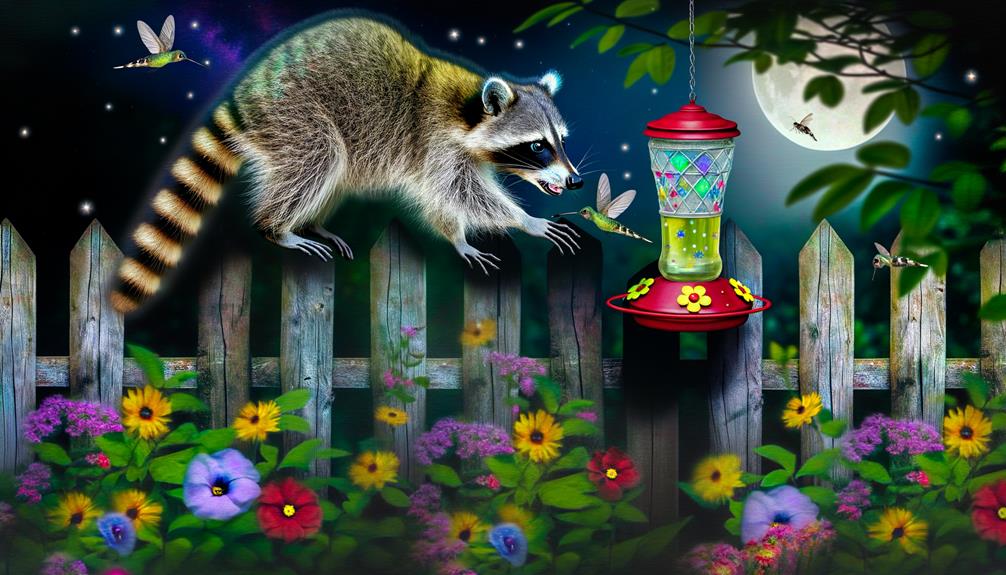
Key Takeaways
- Raccoons are attracted to hummingbird feeders due to the high-caloric artificial nectar.
- Their nocturnal nature leads them to visit feeders primarily at night.
- Raccoons have a keen sense of smell that helps them locate feeders.
- Tipped-over feeders and spilled nectar are signs of raccoon activity.
- Preventing access includes elevating feeders and using baffles or motion-activated deterrents.
Raccoon Dietary Habits
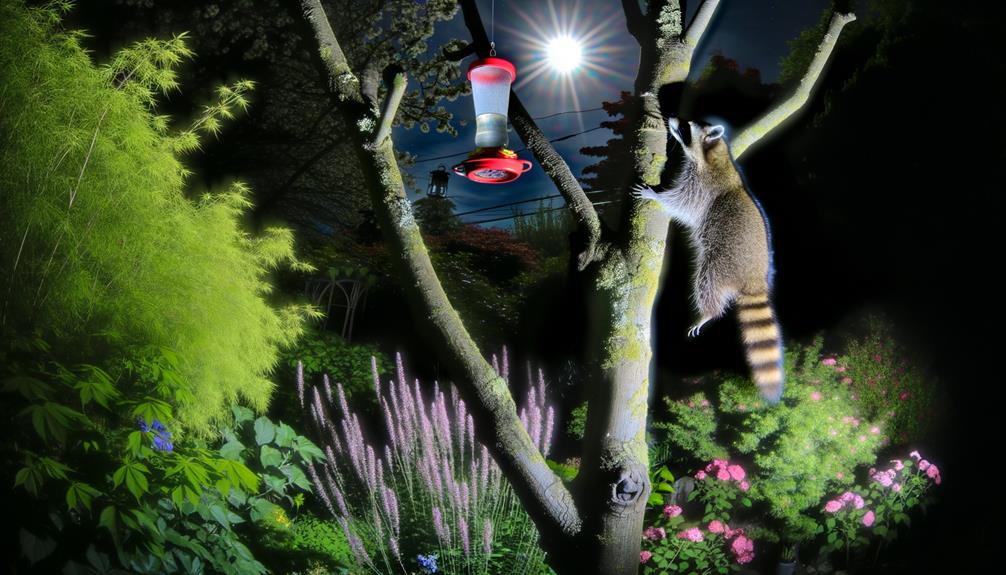
Raccoons, known for their opportunistic feeding behaviors, exhibit a highly varied diet that includes fruits, vegetables, small animals, and human food waste. Their omnivorous nature allows them to adapt to different environments, foraging for whatever nutrient sources are available.
Studies indicate that raccoons consume a broad spectrum of natural foods such as nuts, berries, and insects, while also scavenging from human refuse and compost bins. Seasonal changes influence their dietary patterns, with a higher intake of fruits and insects during warmer months and a shift towards nuts and seeds in colder periods.
This dietary flexibility is a key factor in their survival and proliferation across diverse habitats, from urban areas to wild forests.
Attraction to Hummingbird Feeders
Hummingbird feeders, often filled with sugary nectar, can attract raccoons due to their sweet aroma and easy accessibility. Scientific studies indicate that raccoons, being opportunistic feeders, are drawn to high-caloric food sources, including artificial nectar.
The nocturnal nature of raccoons also means they are more likely to approach feeders during the night when human activity is minimal. Research has shown that raccoons have a keen sense of smell, which helps them locate these feeders.
Additionally, the feeders' placement—typically in gardens or near homes—provides an accessible food source for raccoons. Consequently, the combination of the sweet scent and strategic placement makes hummingbird feeders a potential attractant for these nocturnal mammals, posing a challenge for maintaining exclusive feeding zones for hummingbirds.
Signs of Raccoon Activity
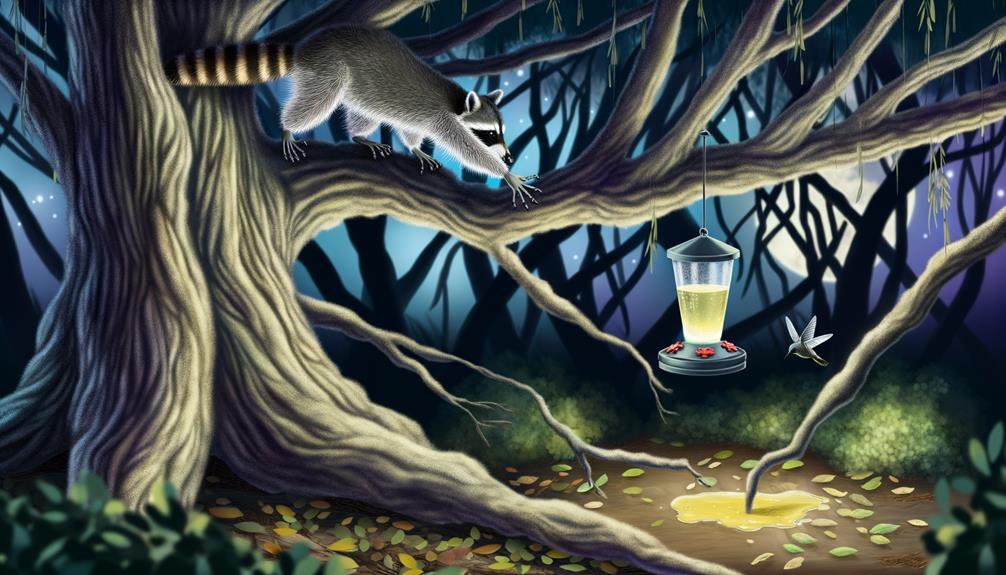
Identifying signs of raccoon activity around hummingbird feeders is essential to understanding and mitigating their impact on these feeding stations. Evidence of raccoon presence includes tipped-over feeders, chewed or damaged feeder parts, and spilled nectar.
Footprints, characterized by their distinctive five-toed pattern, may be visible in soft ground or around the feeder area. Additionally, raccoons often leave behind coarse, dark-colored fur caught on feeder structures or nearby vegetation.
Scratches or claw marks on posts or trees leading to feeders can also indicate raccoon attempts to access the food. Recognizing these signs enables timely intervention to protect hummingbird feeders from raccoon interference, ensuring that they remain effective and undisturbed.
Impact on Hummingbirds
The presence of raccoons consuming hummingbird food can lead to a decreased food supply available for hummingbirds, potentially altering their feeding patterns. This scarcity may force hummingbirds to expend additional energy searching for alternative food sources.
Moreover, increased competition stress could arise as hummingbirds face greater difficulty in securing adequate nutrition.
Decreased Food Supply
A significant reduction in available food sources can severely impact hummingbird populations, leading to decreased energy levels and reproductive success. Hummingbirds rely heavily on a continuous supply of high-energy nectar to sustain their rapid metabolism and support long migratory journeys.
When raccoons consume hummingbird food, this crucial resource becomes scarce. The scarcity forces hummingbirds to expend additional energy searching for alternative food sources, potentially compromising their overall health and robustness.
Scientific studies have shown that inadequate nutrition directly correlates with reduced breeding success, as female hummingbirds may lack the necessary energy reserves for egg production and nurturing offspring. Consequently, raccoon predation on hummingbird feeders could inadvertently contribute to a decline in local hummingbird populations, impacting ecological balance.
Altered Feeding Patterns
Changes in the availability of hummingbird food due to raccoon interference can lead to significant alterations in hummingbird feeding patterns.
When raccoons consume nectar from feeders, the reduced food supply can force hummingbirds to expend additional energy searching for alternative food sources.
This disruption can cause hummingbirds to alter their feeding schedules, potentially leading to increased feeding during less favorable times of the day.
Additionally, the need to forage more extensively can impact their overall energy balance, affecting their ability to migrate and reproduce successfully.
Studies have shown that consistent food supply is essential for maintaining regular feeding patterns in hummingbirds, and any disruption can have cascading effects on their physiological and ecological well-being.
Increased Competition Stress
Raccoon interference with hummingbird feeders not only alters feeding patterns but also exacerbates competition stress among hummingbirds. This increased stress can have several detrimental effects on hummingbirds, impacting their overall health and survival rates.
Evidence suggests that raccoon activity at feeders leads to:
- Decreased food availability: Hummingbirds may find less nectar, leading to increased competition.
- Altered feeding times: Raccoons often feed at night, causing shifts in hummingbird feeding behaviors.
- Increased aggression: Limited resources heighten aggressive interactions among hummingbirds.
- Reduced energy reserves: More time and energy spent in competition and less in feeding.
- Potential injury: Aggressive encounters can result in physical harm.
Understanding these impacts is vital for developing strategies to protect hummingbird populations.
Preventing Raccoon Access
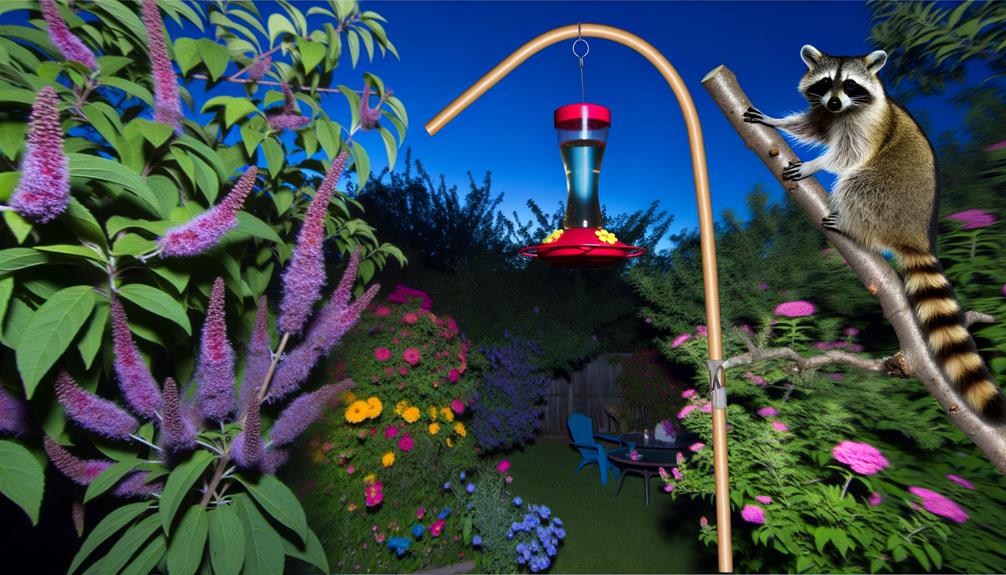
Preventing raccoon access to hummingbird feeders involves strategic measures. Secure feeder placement is essential. Research indicates that placing feeders at elevated heights and away from structures can reduce raccoon interference.
Effective use of baffles is another key strategy. Installing baffles can further deter these nocturnal animals. Also, employing motion-activated lights or alarms can help in preventing raccoons from accessing the feeders.
Secure Feeder Placement
Securing the security of your hummingbird feeder involves strategic placement to deter raccoon access. Positioning the feeder properly can greatly reduce the likelihood of raccoons reaching it, thereby preserving the nectar for hummingbirds. Research indicates that feeders placed in hard-to-reach locations are less likely to be disturbed by raccoons.
Consider the following recommendations:
- Height: Suspend the feeder at least 10-12 feet above the ground.
- Distance: Ensure the feeder is at least 4-6 feet away from any vertical surfaces or branches.
- Smooth Surfaces: Use poles or hangers that are challenging for raccoons to climb.
- Obstacle-Free: Avoid placing the feeder near structures that raccoons can use as leverage.
- Isolation: Position the feeder in a clear, open space to minimize access points.
These measures can effectively deter raccoons from accessing hummingbird feeders.
Use Baffles Effectively
Utilizing baffles can impede raccoons from accessing hummingbird feeders by physically blocking their approach.
Baffles, typically dome or cylindrical in shape, are installed above or below feeders to create a barrier that raccoons cannot easily bypass. Evidence suggests that raccoons, despite being agile climbers and problem solvers, often fail to navigate around well-positioned baffles.
When selecting a baffle, consider materials that are durable and weather-resistant, such as metal or heavy-duty plastic. The placement is vital; baffles should be installed at least four feet above the ground and away from nearby structures that raccoons might use as launching points.
Proper use of baffles effectively reduces raccoon access, ensuring that hummingbird feeders remain undisturbed.
Nighttime Deterrent Methods
In addition to using baffles, implementing nighttime deterrent methods can further minimize raccoon interference with hummingbird feeders. Evidence-based strategies show that raccoons are nocturnal and can be effectively deterred with several approaches. These methods should be both humane and effective, ensuring that raccoons do not harm the feeders or the birds.
Consider the following deterrent methods:
- Motion-activated lights: Startle raccoons and can be an effective deterrent.
- Ultrasonic devices: Emit sounds that are unpleasant to raccoons but inaudible to humans.
- Secure feeders overnight: Bring feeders indoors or use lockable mechanisms.
- Spicy deterrents: Use capsaicin-based sprays that raccoons find unappealing.
- Physical barriers: Install fencing or netting around feeder areas.
These methods can substantially reduce raccoon activity at hummingbird feeders.
Safe Feeder Placement
Proper placement of hummingbird feeders is essential to minimize the risk of attracting raccoons and other unwanted wildlife. Position feeders at least 10-12 feet above ground level and away from trees or structures that raccoons can climb. Utilizing poles with baffles can further deter climbing animals. Evidence suggests that placing feeders in open areas reduces the likelihood of raccoon access. Consider using feeders with built-in ant moats, which can also impede raccoons. Below is a summary table for ideal feeder placement:
| Placement Strategy | Description |
|---|---|
| Height | 10-12 feet above ground |
| Distance from Climbable Objects | Away from trees and structures |
| Use of Baffles | Install baffles on poles |
| Open Area Placement | Reduces raccoon access |
Alternative Wildlife Solutions
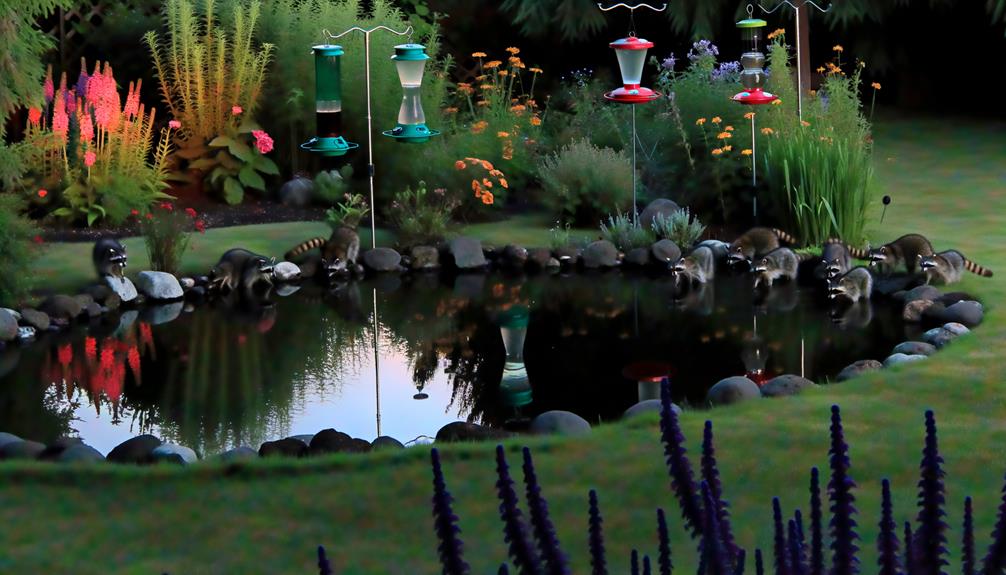
To effectively prevent raccoons from accessing hummingbird feeders, several alternative wildlife deterrent strategies can be employed. Evidence-based methods suggest a multifaceted approach to guarantee the safety of both the feeders and the birds.
Consider the following recommendations:
- Use raccoon baffles: Install baffles specifically designed to prevent climbing.
- Elevate feeders: Place feeders at a height that raccoons cannot easily reach.
- Secure feeding areas: Employ locking mechanisms on feeder ports.
- Repellent sprays: Apply non-toxic, pet-safe repellents around the feeder.
- Motion-activated deterrents: Utilize devices that emit sounds or water to scare raccoons away.
These strategies, when combined, can effectively reduce raccoon interference, guaranteeing that hummingbirds can feed safely and without disruption.
Conclusion
To conclude, raccoons, omnivorous by nature, are often drawn to hummingbird feeders because of the sweet nectar. Signs of their presence include moved feeders and disturbances during the night.
Raccoons can have a detrimental effect on hummingbird populations by restricting their food sources. Taking steps like securely placing feeders and using other wildlife control methods can help address these problems.
It is crucial to make sure that feeders are resistant to raccoons to preserve a harmonious ecosystem in your yard.





